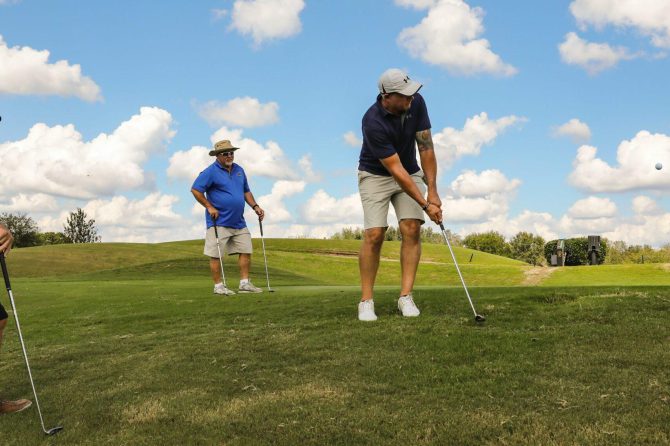Boosting Cognitive Skills in Golf: The Advantages of Slow-Motion Swing Practice
The quest for the ideal golf swing drives many enthusiasts to explore various techniques. One method gaining traction is slow-motion swing practice, recognized for its cognitive benefits. This article explores the psychological foundations of this approach, revealing the complex interplay between mental and physical aspects in achieving golfing excellence.
The Mind-Body Connection in Golf: Understanding Slow-Motion Practice
Golf is often seen as a leisurely activity, yet it provides a unique opportunity to delve into the intricate relationship between mind and body. Incorporating slow-motion swing practice into this sport reveals significant cognitive enhancements that extend beyond just playing on the course.
By carefully analyzing their swings at a slower pace, golfers embark on a journey of kinesthetic learning. This increased body awareness sheds light on their movements’ mechanics, leading to a deeper comprehension of the game. Dissecting each swing becomes an analytical task that sharpens focus and enhances cognitive abilities. Improved perception and refined motor skills translate directly into better performance on the course as players learn to anticipate challenges effectively.
Research indicates that practicing swings slowly can enhance decision-making skills while minimizing errors. By breaking down complex actions into manageable segments, golfers have more time to evaluate situations and make informed choices—this strategic mindset leads to fewer misplayed shots overall.
Refining Motor Skills Through Deliberate Practice: Precision in Every Swing
Slow-motion practice presents an exceptional chance for golfers to hone their motor skills with enhanced precision. The deliberate pace allows individuals to observe every detail of their swings closely, promoting optimal biomechanics and muscle activation patterns.
This focused approach not only improves kinesthetic awareness but also strengthens coordination—resulting in greater consistency during swings. Additionally, practicing at reduced speeds helps forge stronger neural connections between brain and body; repeated controlled execution enables better analysis of feedback leading to improved muscle control.
A study from UCLA highlighted how participants engaging in slow-motion practices showed marked improvements in both swing consistency and ball striking accuracy compared with those who practiced at regular speeds—underscoring both cognitive and physical advantages inherent within this technique.
The Psychological Benefits of Slow-Motion Training: Cultivating Confidence and Concentration
The psychological advantages derived from slow-motion golf practice significantly enhance overall performance levels among players.
- Confidence Building: Isolating specific movements allows golfers to identify inconsistencies or errors within their technique; understanding these mechanics fosters self-assurance as they make necessary adjustments over time.
- Enhanced Focus: Practicing slowly encourages full engagement with each aspect of one’s swing; concentrating on individual movements cultivates sustained attention throughout playtime which ultimately leads towards improved shot control.
- Anxiety Reduction: A controlled environment promotes relaxation while learning new techniques—lessening stress levels associated with competitive play scenarios!
Aiming for Performance Efficiency: Maximizing Results Through Methodical Techniques
Swing training through slow motion serves not only as an enhancement tool but also contributes significantly towards achieving peak performance efficiency across all facets involved within golfing activities! Breaking down motions facilitates detailed comprehension regarding how each action impacts overall strokes taken during gameplay sessions!
Your Practical Guide To Implementing Effective Strategies For Improvement!
- Select Specific Movements: Begin by isolating elements such as backswing or downswing when practicing slowly focusing intently upon maintaining proper form throughout these motions ensuring maximum precision achieved along way!
- Add It To Warm-Ups: Incorporate gradual increases from slower tempos up until fluidity builds naturally allowing activation appropriate motor patterns enhancing efficiency ultimately resulting better outcomes achieved during actual rounds played later down line!
Main Benefits Of Engaging In Regularly Scheduled Sessions Of This Nature Include:
- – Reduced tension & anxiety through relaxed approaches taken towards learning new concepts;
- – Improved focus & attention directed specifically onto forms utilized throughout entire process;
- – Greater proprioceptive awareness enabling enhanced movement controls developed over time;
swing training via deliberate pacing offers substantial cognitive enhancements benefiting all aspects related directly back toward improving one’s game! By fostering mindful engagement alongside refining essential skill sets required out there amongst competitors alike—it empowers individuals striving toward greater success consistently found upon courses everywhere today!

Unlocking Your Golf Game: How Slow-Motion Swing Practice Boosts Cognitive Skills and Performance
Meta Title
Unlock Your Golf Game: The Power of Slow-Motion Swing Practice
Meta Description
Discover how slow-motion swing practice enhances cognitive skills and boosts golf performance. Learn techniques, benefits, and tips to improve your game today!
Understanding the Mechanics of Slow-Motion Swing Practice
Slow-motion swing practice is an effective method that allows golfers to break down each component of their swing. By decelerating the motion, players can focus on mechanics, body alignment, grip, and timing. This technique helps in building muscle memory, crucial for a consistent swing.
How Slow-Motion Practice Enhances Cognitive Skills
Engaging in slow-motion practice not only works on physical muscle memory but also significantly enhances cognitive abilities. Here’s how:
- Increased Focus: Slowing down allows you to pay attention to details that are often missed during regular practice.
- Visual Learning: Observing your swing in slow motion can help you visualize improvements and recognize mistakes.
- Enhanced Problem-Solving: Analyzing your swing mechanics encourages critical thinking and decision-making on the course.
Benefits of Slow-Motion Swing Practice
Implementing slow-motion practice into your routine offers numerous advantages:
- Improved Mechanics: Focus on key factors such as grip, stance, and follow-through.
- Greater Consistency: Regular practice leads to a more repeatable swing.
- Injury Prevention: Slow practice reduces the risk of overuse injuries by allowing the body to adapt gradually.
Practical Tips for Incorporating Slow-Motion Practice
To maximize the benefits of slow-motion swing practice, consider the following strategies:
- Use Video Analysis
– Record your swings and analyze them frame by frame.
– Look for inconsistencies in your form.
- Focus on Key Positions
- Identify several key positions in your swing (e.g., top of the backswing, impact).
– Concentrate on achieving the correct position in slow motion.
- Incorporate Drills
– Grip Drill: Practice gripping the club in slow motion, paying attention to your hand placement.
- Swing Path Drill: Focus on the path of your clubhead during the downswing.
- Mindful Breathing
– Incorporate deep breathing to enhance relaxation and focus during practice.
Case Study: Success Through Slow-Motion Practice
A high school golf team implemented slow-motion swing drills twice a week. They recorded their sessions and reviewed them collectively. Over the course of the season, their scores improved drastically, with an average drop of 5 strokes per player. This practical application of slow-motion practice showcased its effectiveness in enhancing both skill and teamwork.
First-Hand Experience: A Golfer’s Journey
After struggling with consistency on the course, I decided to incorporate slow-motion swing practice into my routine. Initially, it felt awkward, but with time, I noticed significant improvements. Recording my swings allowed me to spot flaws, leading to better grip and posture adjustments. My scores improved, and I felt a deeper connection to my swing.
Recommended Slow-Motion Drills
| Drill Name | Description | Purpose |
|———————|——————————————|——————————|
| Grip Check Drill| Practice gripping the club slowly, ensuring correct placement. | Enhances grip consistency. |
| Backswing Pause| Pause at the top of your backswing, then return to impact. | Fosters control and awareness. |
| Follow-Through Focus| Extend your follow-through slowly to build confidence. | Improves finishing position. |
Advanced Techniques for Cognitive Enhancement
- Visualization Techniques: Before practicing, visualize your ideal swing. This mental rehearsal prepares your mind for the physical execution.
- Mindfulness Training: Incorporate mindfulness exercises to improve on-course focus and clarity.
- Pattern Recognition: Analyze different swings of professional players and identify patterns that could enhance your game.
Integrating Technology with Slow-Motion Practice
Utilizing technology can amplify the effects of slow-motion practice. Here are some tools that can enhance your experience:
- Smartphone Apps: There are several golf swing analysis apps that allow you to record, analyze, and compare your swings.
- Motion Capture Sensors: Wearable devices can give real-time feedback on your swing mechanics.
- Virtual Reality (VR): Engage with VR training programs to practice your swing in a simulated environment.
Conclusion
By incorporating slow-motion swing practice into your routine, you not only enhance your physical skills but also your mental capabilities. This multifaceted approach leads to a more comprehensive understanding of the game and, ultimately, improved performance.





